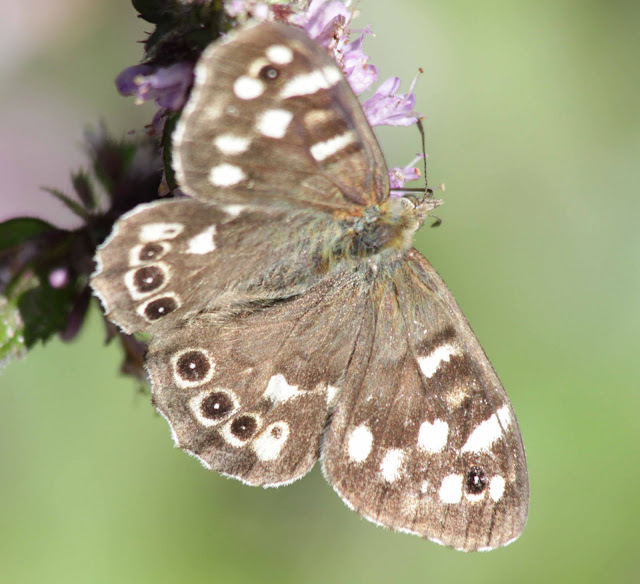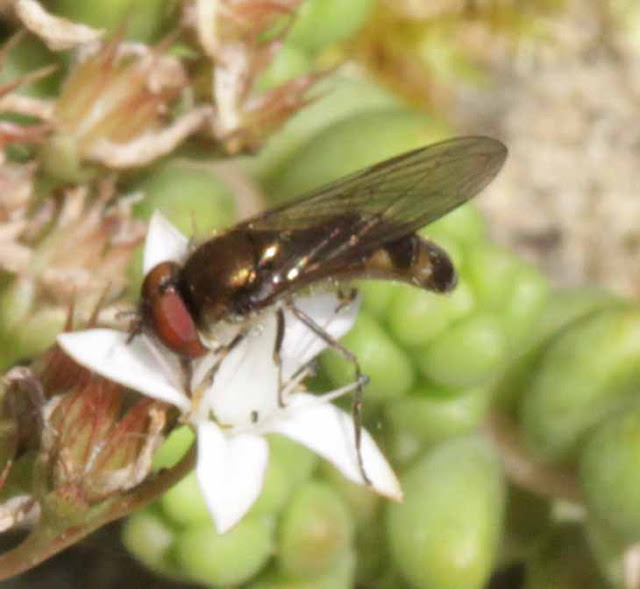Having arrived at the house at Tomich late last night to stay with Paula's parents, Ken and Pam, we woke to a really nice Highland day today. As we were getting the painting of the garage eaves organized, a very nice speckled wood butterfly, Pararge aegeria, appeared in the back garden, nectaring repeatedly on the mint flowers by the vegetable patch.
Surprisingly well coloured for the time of year, the mix of grey-green and tawny hairs on the body showed very well in a photo taken with the sun from behind the wings.
This was a very interesting butterfly to see up here, as it is one of the butterflies that has extended its range over the last few decades and recolonised large areas of Scotland. It is also relatively unusual to see it nectaring on flowers but it will do this early and late in the season when aphid activity is low, and the availability of honeydew on leaves that it normally depends upon throughout the majority of its long season is correspondingly reduced.
In the garden there were plenty of Episyrphus balteatus hoverflies
and then suddenly there was a rather dumpy hoverfly running over a leaf surface. As I got the camera ready I could see that the legs were distinctly banded, black and pale (the pale sections being much whiter than the yellow illustrated in the book), the main part of the abdomen looked orangey and there was a dark tip to it.
The wings were kept firmly folded over the back, so everything beneath was a bit blurred, which was rather frustrating. I thought of Xylota segnis, a hoverfly that I knew to be common, but that I had previously had difficulty in finding, and I think this is what it must have been.
There is also a rare species, Xylota tarda that is only found in the Scottish highlands possibly associated with Aspen, Populus tremula, (there are Aspen trees within 200 m of the garden), but I couldn’t see the critical features clearly, so this remains just an intriguing possibility!! It did look so much like tarda though!
Then there was another small hoverfly, which looked as though it had grey abdominal spots. One possibility is Meligramma or Melanogyna, but again it was too difficult to see the diagnostic characteristics to be sure even that I had the right genus.
I also managed to get some shots of the birds on and around the bird feeders, mainly tits, chaffinches and siskins on the peanuts.
I also found a white-lipped banded snail Cepea hortensis on one of Pam’s plants, so I removed it, although it didn’t seem to be doing any damage!
There was a very nice parasitic wasp in the borders, which posed for a moment, and then went off looking for caterpillars to attack.
Common carder bees, Bombus, and white-tailed bumble bees, Bombus, visited the border flowers.
A very bright specimen of the hoverfly Eristalis pertenax was seen on the Michaelmas Daisies, again weeks after they seemed to disappear from around Hadlow.
A grey-dusted Tachinid fly also searched the Michaelmas Daisies, Aster, for pollen or nectar.
There was also a Heteropteran bug, possibly a capsid, but these are all difficult groups.
I saw two froghoppers along the road earlier on this morning, and this one on the Fuchsia flower looked the same. The larvae are found in the familiar cuckoo-spit earlier in the year and the adults aren’t found until the autumn, so its nice to see these now.
This small male hoverfly feeding off the Sedum is a little bit easier to identify because of the combination of its pale swollen front leg tarsal segments (swollen on the male only) and its grey rather than yellow spots, making it a Platycheirus. It is most likely to be P. albimanus, but there are a number of other possibilities. You can tell it’s a male because its eyes touch at the top of the head, as noted in many species of hoverflies and other flies.
On the other side of the drive the broom, Cytisus scoparius, seed-pods were swelling until they were fit to burst
and explosively released their seeds with the occasional sharp cracks, the pods twisting into their spiral halves.
Overall a pretty lively garden for wildlife at this time of year!
Then there was another small hoverfly, which looked as though it had grey abdominal spots. One possibility is Meligramma or Melanogyna, but again it was too difficult to see the diagnostic characteristics to be sure even that I had the right genus.






















No comments:
Post a Comment